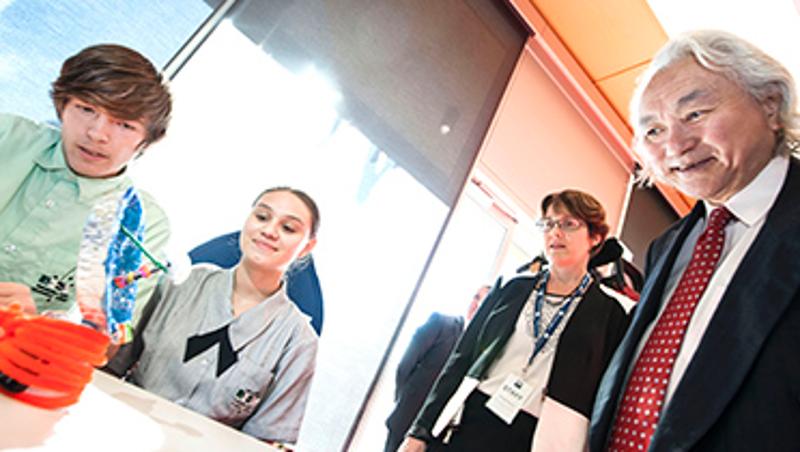
Robot butlers and mass produced flying cars may never be but your intelligent wallpaper will give you medical and legal advice, predicts one of the world great science visionaries.
Speaking at QUT, American futurist Dr Michio Kaku said the computer will make way for internet-enabled surfaces such as walls, floors and contact lenses - and this will revolutionise our world, including health care.
"(Everyone) will have two disks in the future," Dr Kaku said.
"One is your genome. It cost $3 billion to sequence the first human. In the future it will cost $100 to have a disk with all your genes on it.
"And you will have a second disk, one with all the neutral pathways of (your) brain - all your memories, thoughts, desires, emotions encoded in it."
But Dr Kaku warns that only countries investing in science will reap the rewards. For those that do not, he predicts bankruptcy and poverty.
"Some people think we can cut the science budget and get away with it," Dr Kaku said.
"Well, yes, you can cut the science budget but you pay a price, because you're eating and destroying the future by cutting the science budget.
"Science is the engine of prosperity. Science generates wealth."
Dr Kaku is a world-renowned theoretical physicist, the co-founder of string field theory and a visionary science communicator.
In his first stop on his inaugural Australian tour, Dr Kaku explored QUT's multi-awarding winning interactive display space, The Cube.
Designed, prototyped, developed and built by QUT staff, The Cube is the world's largest digital interactive installation.
All but one of the nine programs on display at The Cube were developed by QUT staff, right down to the skin on the whale in the Virtual Reef installation, which was drawn by hand to achieve its realistic look.
Dr Kaku was given a sneak peak at QUT's upcoming installation, Microsoft Research's WorldWide Telescope (WWT), a web portal that brings together imagery from the world's best telescopes, enabling people anywhere to explore the universe.
QUT staff collaborated closely with Microsoft to bring the company's WWT to life on The Cube, developing a custom interface for The Cube's touch screen system and helping Microsoft improve its WWT interface to enhance public interaction with the program.
Dr Kaku said universities like QUT would be at the forefront of creating jobs and industries for the future.
"Technology will make it possible to take the human mind's creations and make industries out of these creations - and that, I think, is one of the messages of this university.
"Out of this university will come not just bright kids with the stars in their eyes but entire industries that employ people."
QUT research robot caught Dr Kaku's eye. Roboticists with the QUT-led ARC Centre of Excellence in Robotic Vision are using the Adept Guiabot to develop new sensing technologies that allow robots to navigate among people, manipulate objects and interact with humans inside a changing environment such as hospitals, farms, other workplaces and inside our homes.
Dr Kaku also met with Bundamba Secondary College students who were building miniature satellites and programming rocket launches in QUT's state-of-the-art science, technology, engineering and mathematics (STEM) classroom.
Some of the Grade 11 and 12 students visited NASA last year as part of the first-ever Australian school contingent to complete its Space School Program. Other students in the classroom will visit NASA in 2015.
"Commodities will matter less in the future because more and more value will come from the mind, and Australia is poised to leap into the future because it has both commodities and an educated population," Dr Kaku said.
"(Australia) needs to encourage young people to leap to the forefront of intellectual capital and that's what this university is all about - I'm talking about STEM technologies."
Presented by QUT's Institute for Future Environments (IFE), Dr Kaku will tonight explore the scientific and technological marvels that will change our lives over the next 50 years with a packed audience at the Brisbane Convention and Exhibition Centre.
While tickets are now sold out, the public can still see the IFE's foyer exhibition which includes quantum levitation demonstrations, 3D printing and 3D-printed giveaways, an unmanned aerial vehicle and LEGO robots.
The foyer exhibition is open to the public from 5.15pm.
RELATED STORIES
Developing drought tolerant mungbean
Aust's great young STEM hopes unite at QUT
New institute focuses on Future
Media contact:
Kate Haggman, QUT Media, 07 3138 0358, kate.haggman@qut.edu.au.
After hours, Rose Trapnell, QUT Media team leader, 0407 585 901.


